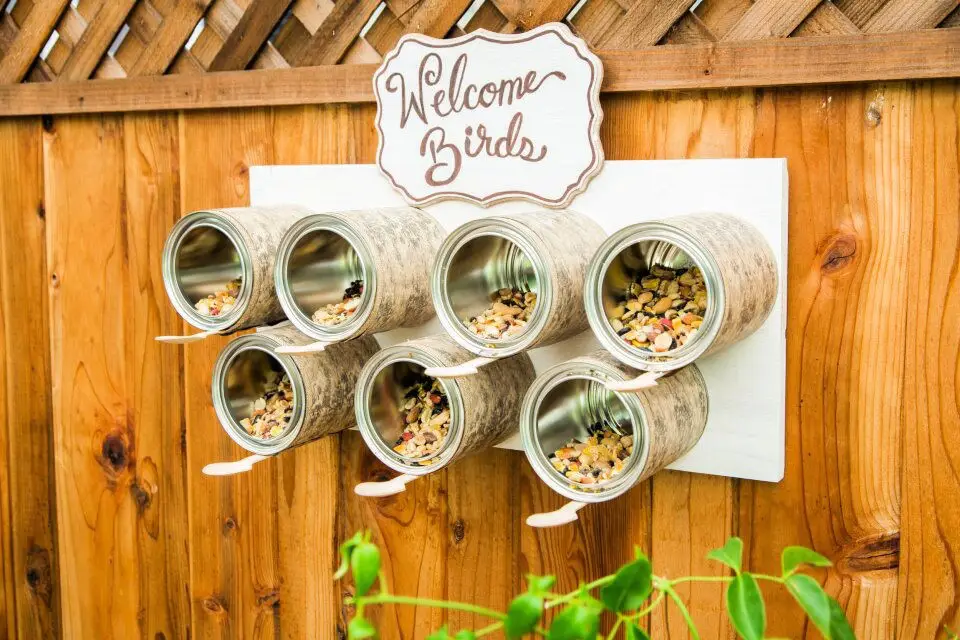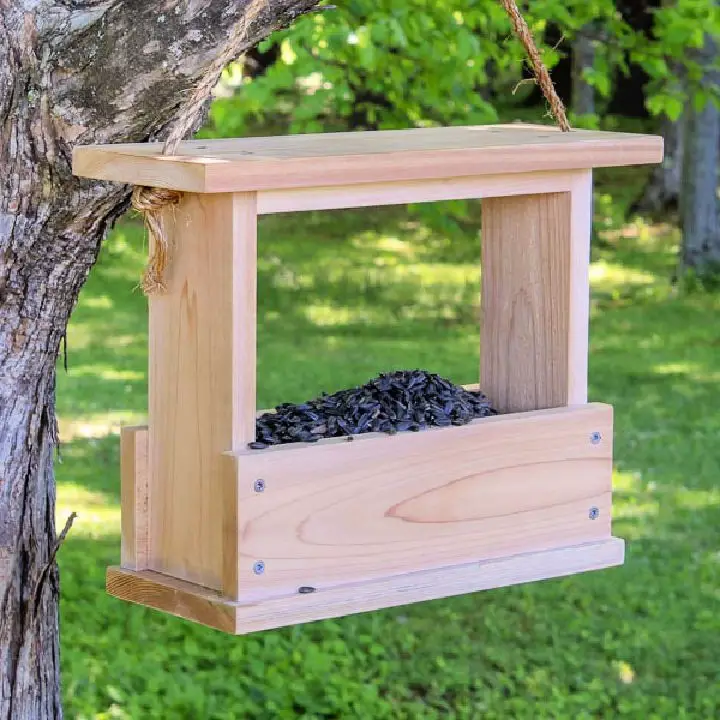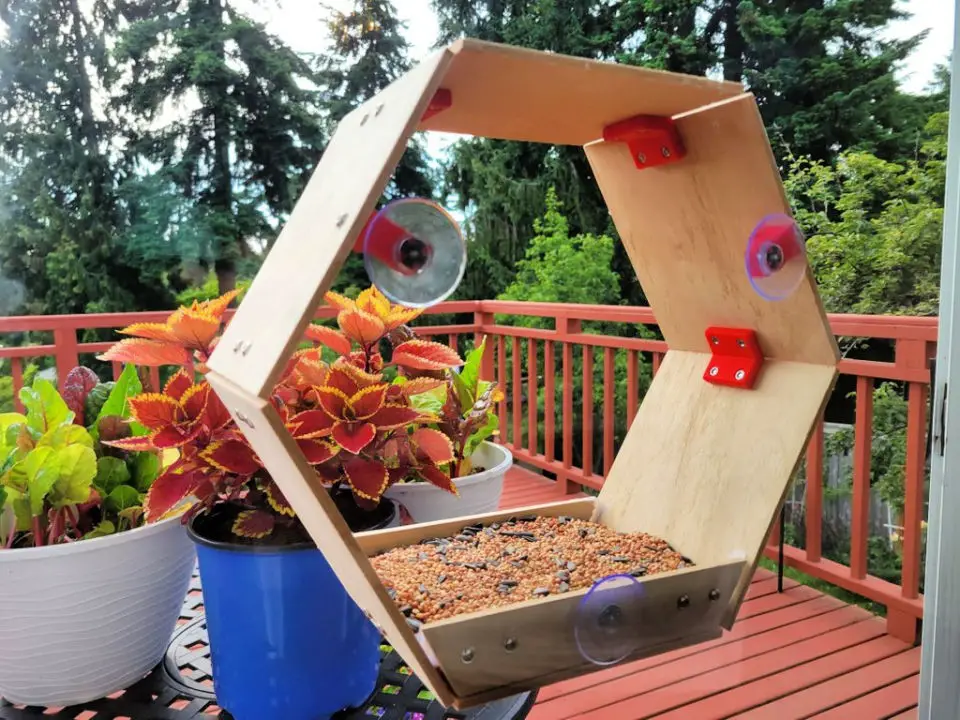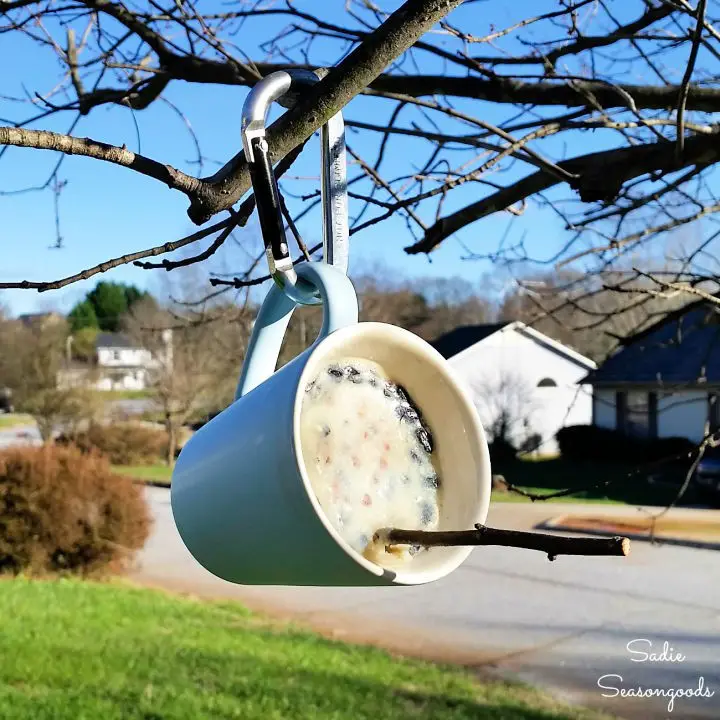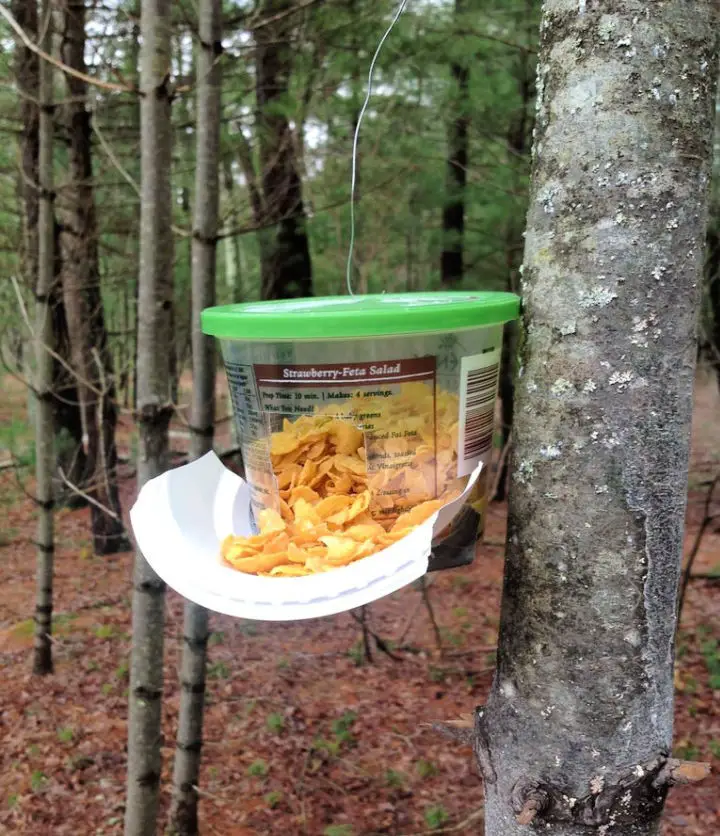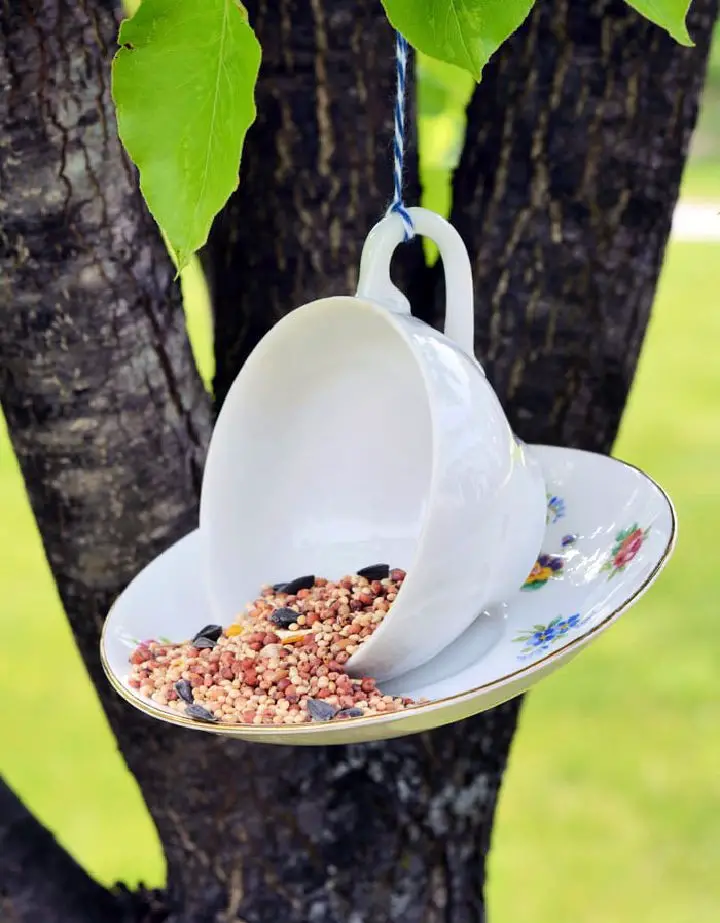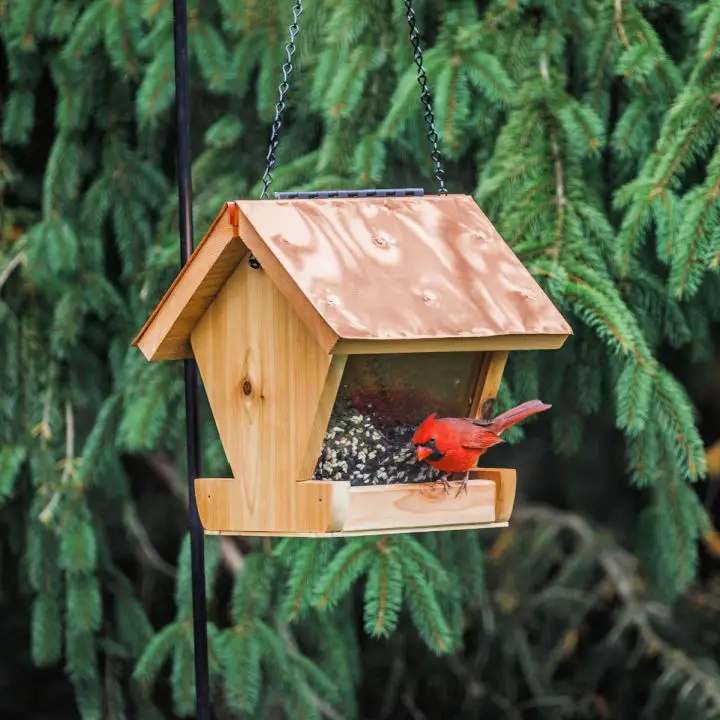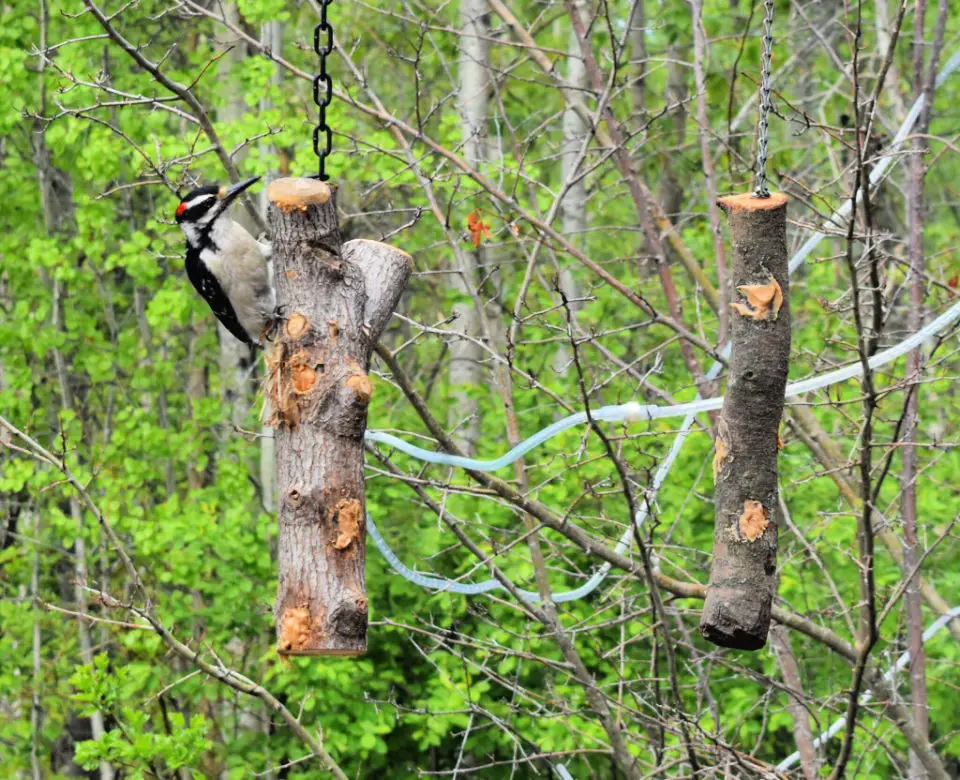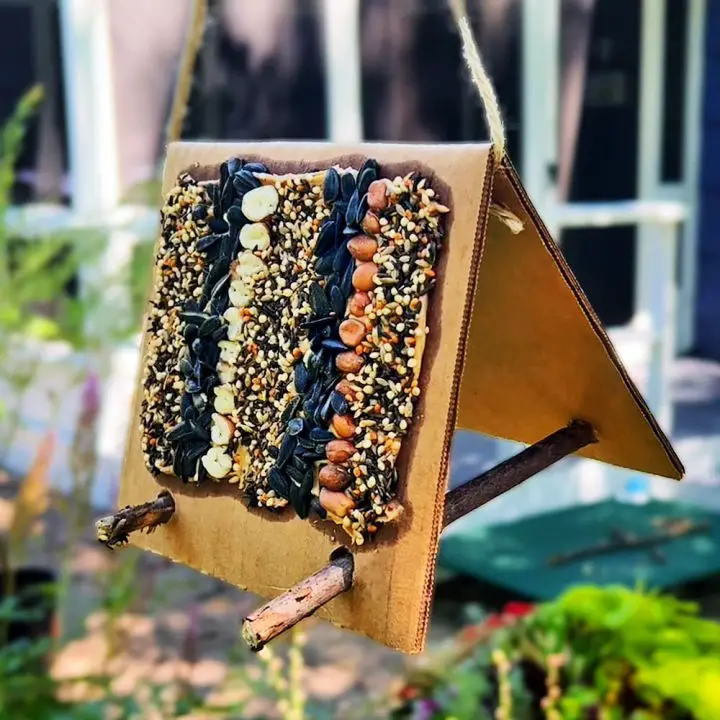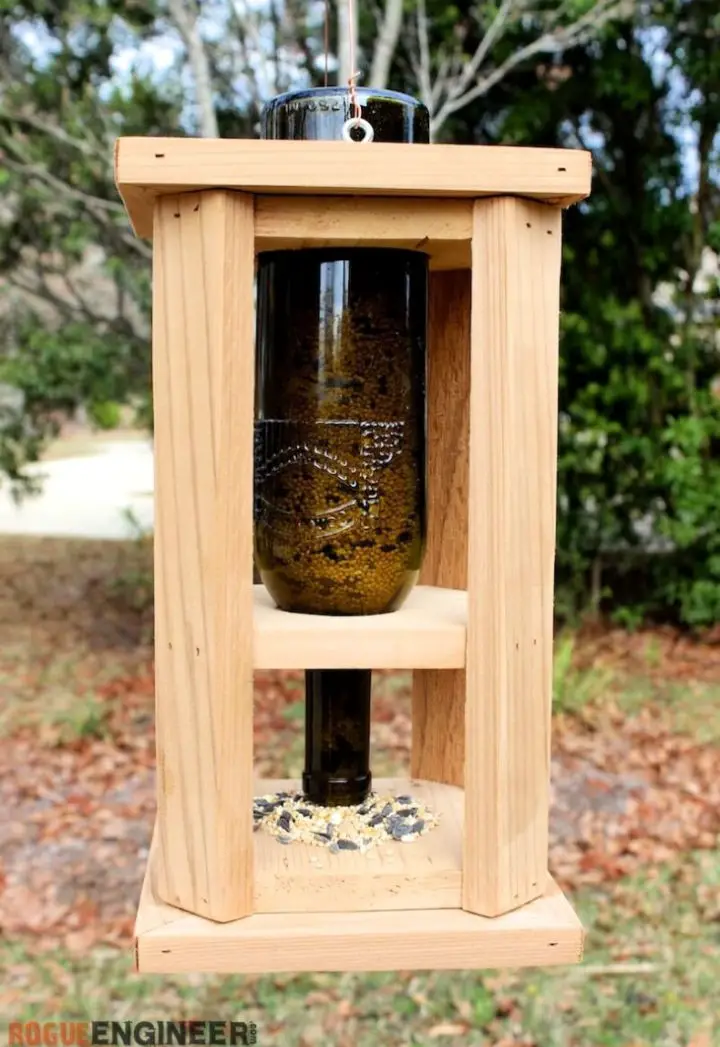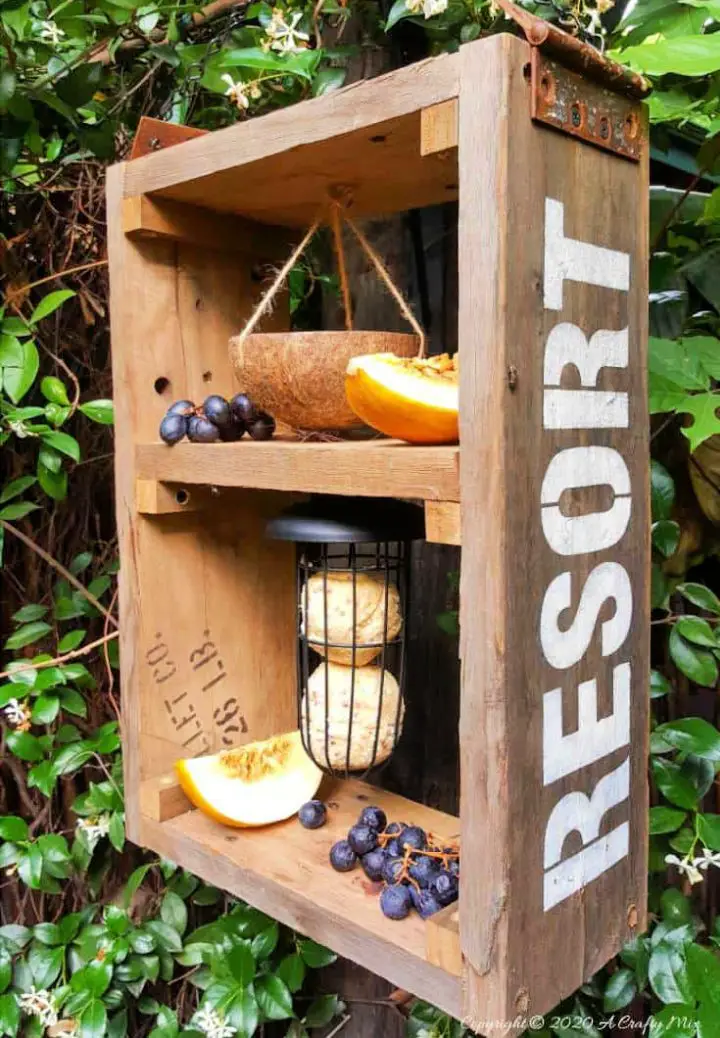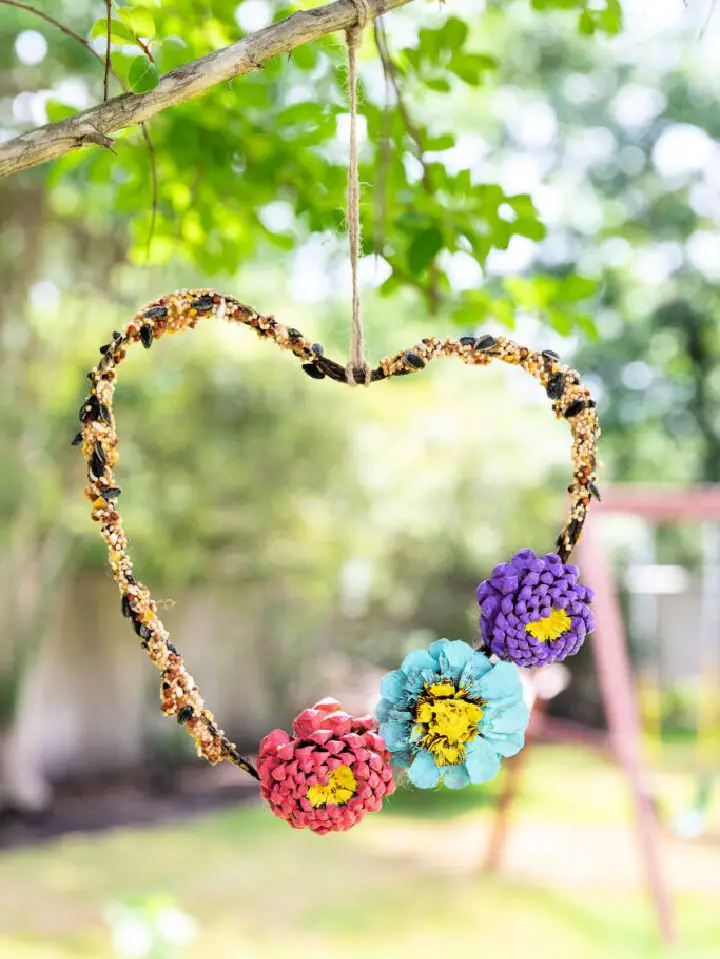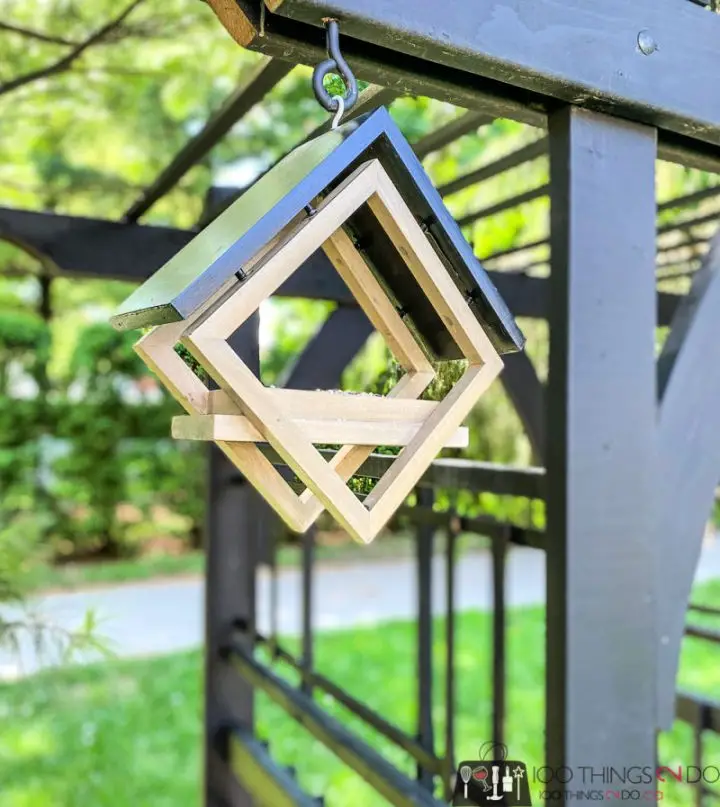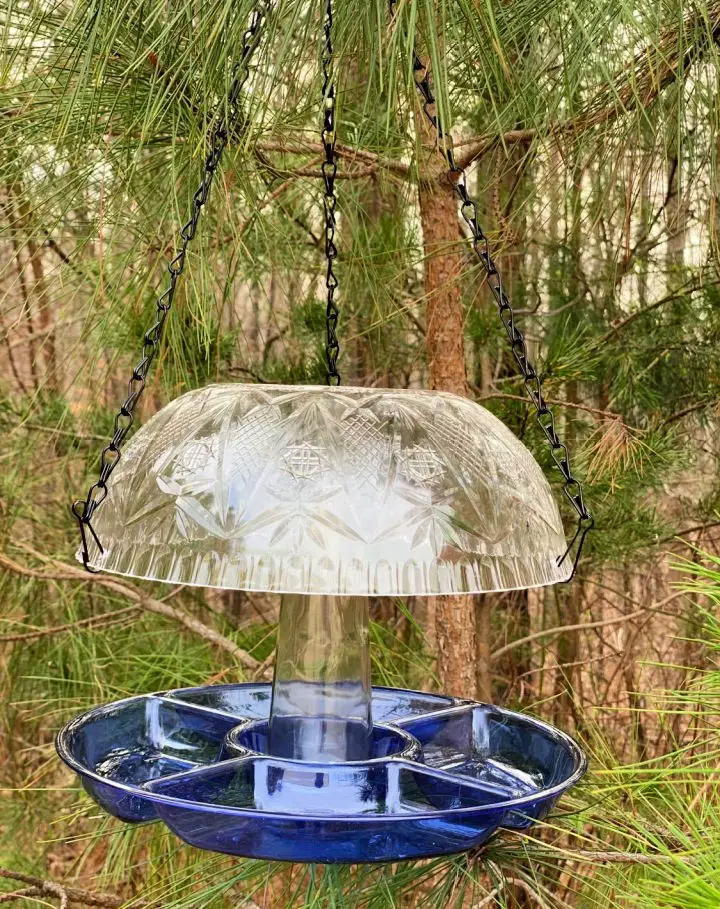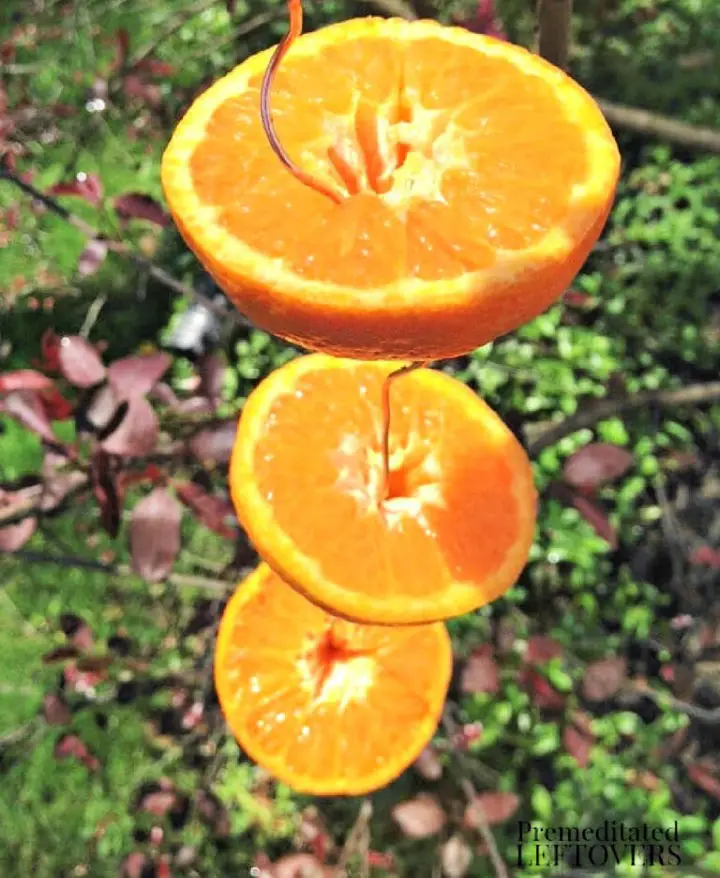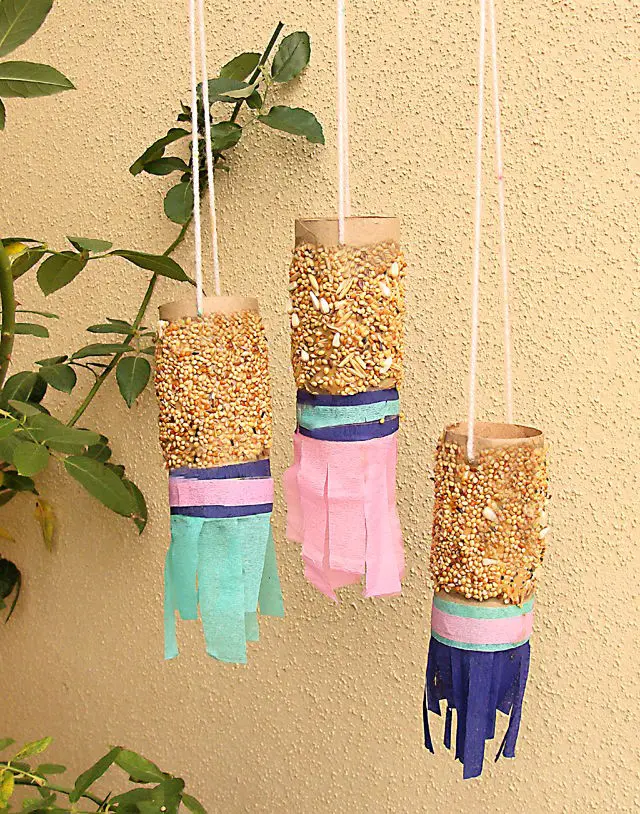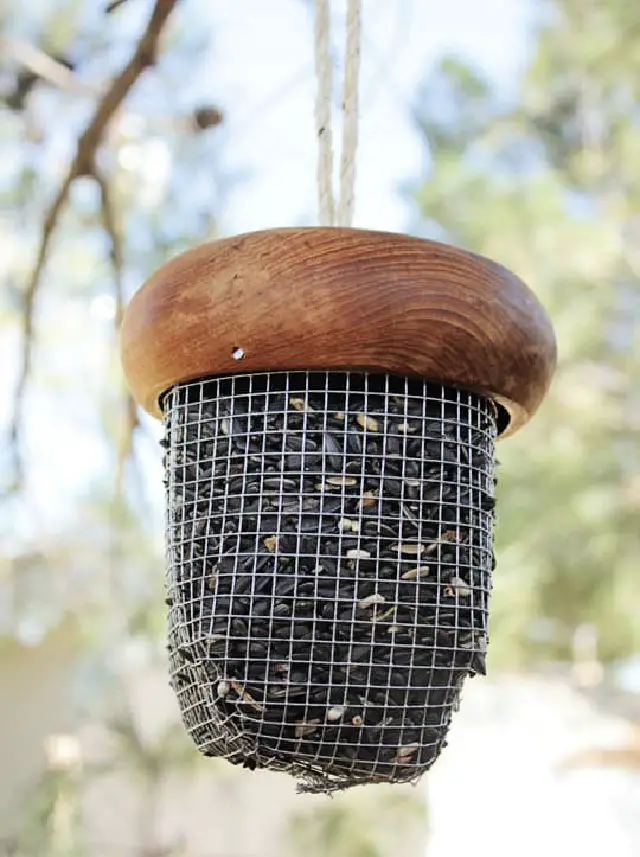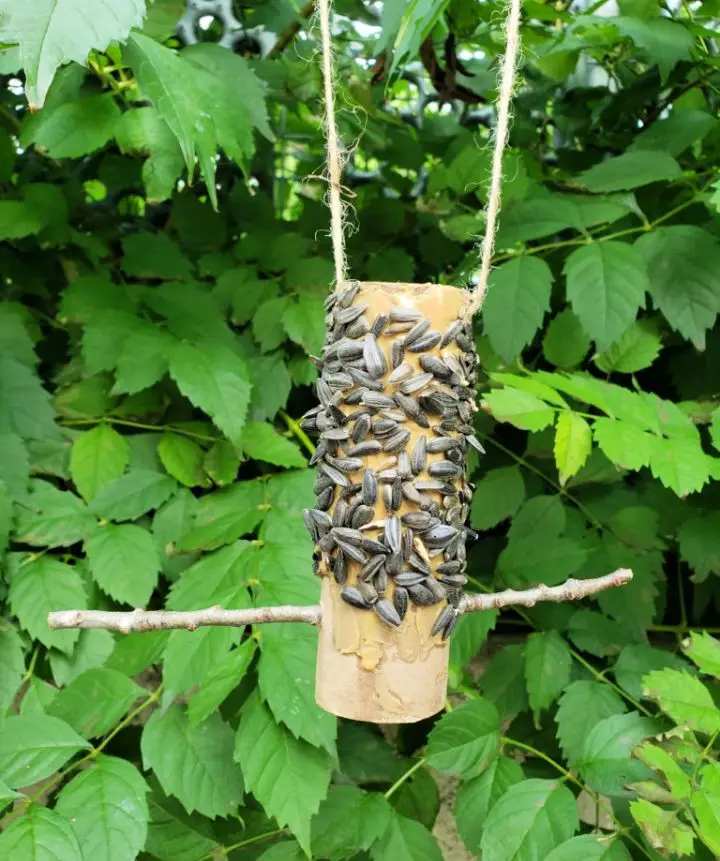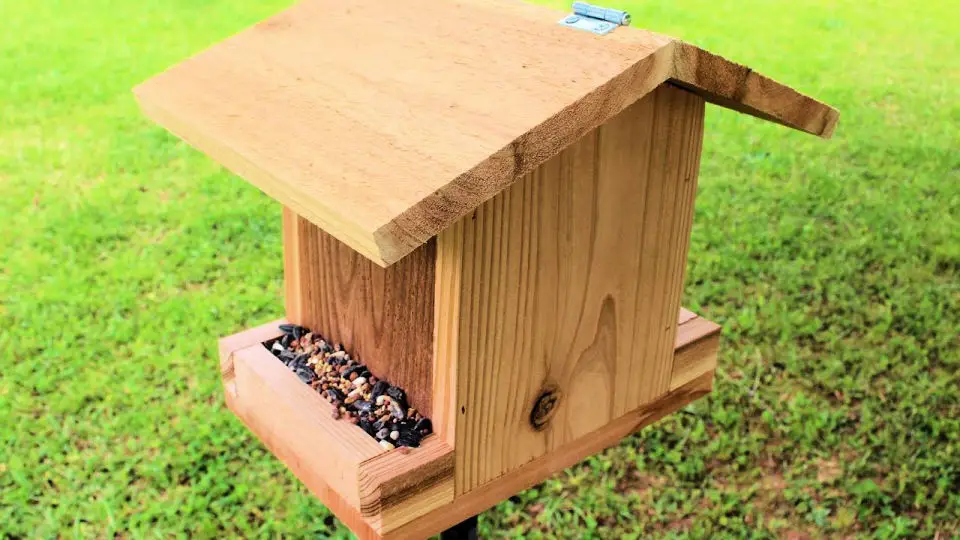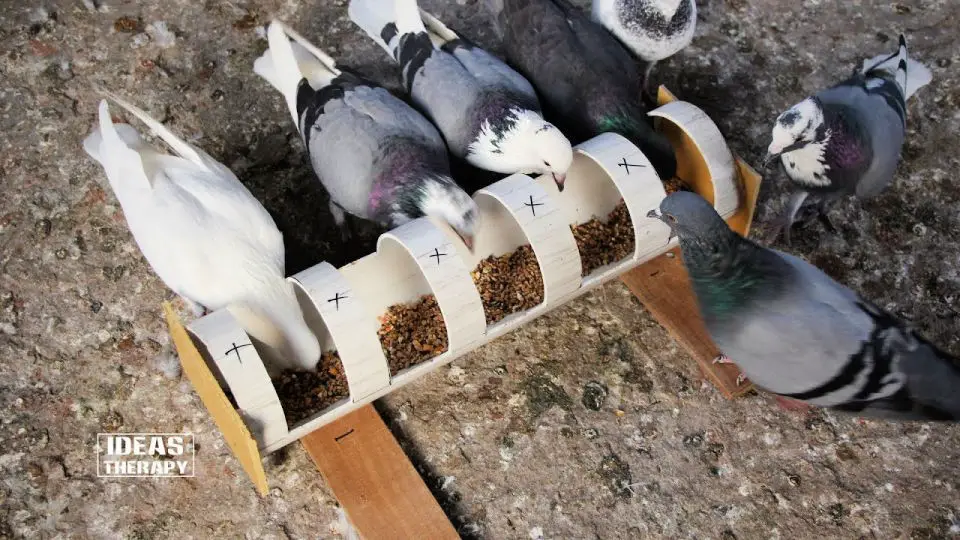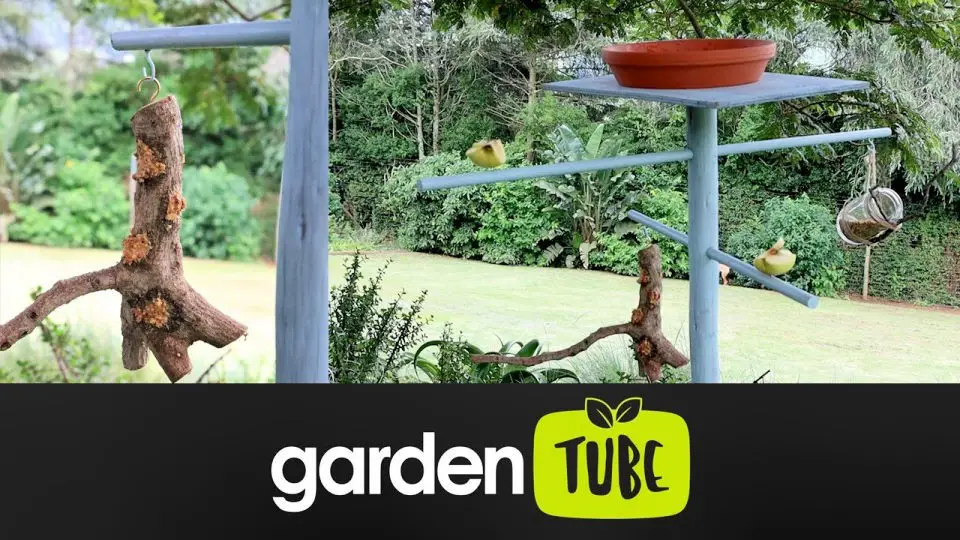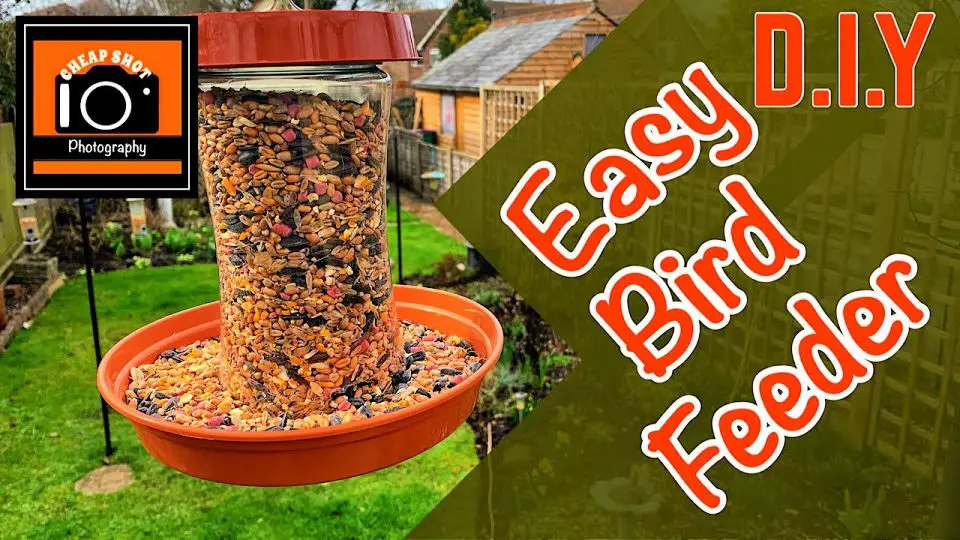Why Make Your Own Bird Feeder?
Creating a bird feeder at home offers a unique combination of benefits for both you and the environment. By building one yourself, you’ll not only be supporting local wildlife but also gaining hands-on experience that can educate and entertain people of all ages.
For instance, using recycled materials in your project reduces waste and promotes sustainability, making it an eco-friendly activity that’s perfect for anyone looking to make a positive impact. By repurposing items like milk cartons or scrap wood into bird feeders, you’ll be helping to conserve resources while creating something truly useful.
Beyond the environmental benefits, building a bird feeder can also have a profound effect on your mental well-being. Watching birds visit your feeder can be incredibly calming and meditative, offering a peaceful escape from the stresses of daily life. It’s not uncommon for people to find themselves feeling more relaxed and at ease when surrounded by nature.
Furthermore, a homemade bird feeder can add charm and character to your garden, serving as a focal point that attracts various bird species and brings color and vibrancy to your outdoor space. It’s a simple yet rewarding way to connect with nature and support local wildlife, making it an excellent DIY project for anyone looking to make a positive impact.
How to Make a Bird Feeder
Transforming a plastic bottle into a bird feeder is a creative DIY endeavor that not only promotes recycling but also supports local avian populations. By repurposing household materials, we can create a functional and easy-to-make bird feeder. This straightforward guide will lead you through the process, utilizing items you may already have on hand.
What You Will Need
To create the necessary materials for your bird feeder, you will need a clean and dry plastic bottle with a cap, twine or string, two sticks, dowel rods, or pencils. Additionally, you’ll require some birdseed to fill your new feeder. You’ll also need a few basic tools to help you assemble everything. These include a drawing pin, commonly known as a thumbtack, and a sharp pair of scissors. The nail scissors work exceptionally well for this task.
Step-by-Step Guide
To create a functional and attractive DIY bird feeder, start by preparing the perches. Use a drawing pin to make two holes opposite each other near the bottom of the bottle, then widen them with scissors until they’re just slightly smaller than the width of your chosen stick. Insert the stick through both holes to form a perch, repeating this step higher up on the bottle to create a cross shape when viewed from below. For proper drainage and feeding, make small holes at the bottom of the feeder using the drawing pin, then widen them with scissors. Additionally, poke slightly larger holes about four centimeters above each perch for the birds to feed from. Adjust the hole sizes based on the size of your birdseed. Next, prepare the feeder for hanging by making two more holes opposite one another near the neck of the bottle. Thread a piece of twine or string through these holes to create a loop for hanging. Finally, fill the bottle with birdseed, ensuring the feeding holes are sized so seeds can be accessed by the birds without spilling out excessively. Screw the cap back on and your DIY bird feeder is ready to be hung in a tree, on a washing line, or any suitable spot.
After Installation:
When you first install the feeder, allow some time for birds to become aware of its presence and start frequenting it. This may take a day or two, depending on the species of birds in your area. Be patient and give them time to discover this new source of food.
Video Tutorial
Incorporating a visual element into the process of crafting a bird feeder from a plastic bottle can greatly enhance comprehension and engagement. For those who prefer a hands-on, step-by-step approach, I recommend watching the EcoSapien video tutorial on this project. This multimedia combination, pairing the written guide with the video, provides a comprehensive learning experience that caters to both visual and textual learners. The activity itself is an excellent way to repurpose everyday waste while promoting a valuable resource for local wildlife. With its simplicity and accessibility, crafting a bird feeder from a plastic bottle is an enjoyable project suitable for individuals of all ages.
Understanding Your Local Bird Species
Not only do birds native to your area bring a burst of vibrancy and melody to your backyard, but they also play a vital role in maintaining the local ecosystem’s overall health. Whether you’re an enthusiastic bird enthusiast or simply appreciate their company, identifying which species can be attracted and learning how to draw them in is crucial for creating a welcoming habitat that benefits both you and the birds.
Mini-Guide to Common Backyard Birds in Different Regions
While a comprehensive list of regional bird species would be exhaustive, identifying a few common visitors can serve as a starting point for exploration. For a more in-depth look, online resources like the Audubon Society and Cornell Lab of Ornithology offer a wealth of information, providing guides and tools to identify and understand local avian populations.
In North America, familiar backyard birds include the Northern Cardinal, American Robin, and Blue Jay, while Europe is home to the European Robin, Great Tit, and Chaffinch. In Australia, common sightings feature the Australian Magpie, Rainbow Lorikeet, and Superb Fairy-wn.
By consulting these resources, you can uncover not only the birds of your region but also their habits, preferences, and how to attract them to your backyard or local park.
Bird Feeder Types and Food Choices
To entice birds to your yard, it’s crucial to consider both the type of feeder and the type of food you offer. Here’s a comprehensive guide to get you started:When it comes to feeders, different types are better suited for various bird species. Tube feeders are ideal for small birds like finches and sparrows, while hopper feeders attract a wider variety of birds including cardinals and blue jays. Suet feeders are perfect for winter months, drawing in woodpeckers, nuthatches, and titmice with their high-fat content. Platform feeders, open and accessible, are ideal for ground-feeding birds like doves and juncos.In addition to choosing the right feeder, selecting the correct food is equally important. Sunflower seeds are a universal favorite among many bird species, while suet provides essential fats, especially beneficial in colder climates. Nectar attracts hummingbirds and orioles, made from a simple sugar-water mixture. Fruits and nuts, loved by a variety of birds including blue jays, woodpeckers, and robins.Remember, the key to a successful bird feeder is not just about attracting birds but also providing a safe and nutritious environment for them. Regularly cleaning your feeders and providing fresh water are just as important as the food itself. By understanding the specific preferences of your local bird species and matching those with the appropriate feeders and food, you’re well on your way to becoming a beloved stopover for the feathered residents of your area.
The Perfect Placement: Location, Location, Location
Safety First: Keeping Our Feathered Friends Safe
When it comes to siting your homemade bird feeder, the well-being of its avian visitors should be the paramount consideration. A crucial aspect of ensuring bird safety is to position feeders away from windows, as this can greatly minimize the risk of collisions with glass, a leading cause of injury or mortality among birds. Additionally, careful thought should be given to potential predators, such as felines and birds of prey. Strategically placing feeders at least 12 feet away from areas where predators may lurk, like bushes or tree cover, provides birds with the opportunity to detect potential threats and make a swift exit.
Maximizing Bird Viewing Pleasure
When it comes to observing the fascinating behaviors of your visiting birds, consider positioning your feeders in areas where you can comfortably view them from within your home. Patios, gardens, or windows with bird-friendly safety measures installed are excellent options. While placing feeders near windows is a great way to enjoy the show, be mindful of the placement to minimize reflection and prevent potential harm to the birds. A sweet spot lies in finding a balance between proximity to the window for optimal viewing and distance that reduces the risk of collisions.
Balancing Sunlight, Trees, and Cover
When it comes to placing your homemade bird feeder, consider positioning it in an area that receives moderate sunlight throughout the day. This will help prevent spoilage from excessive direct sunlight while still attracting birds to feed. A spot with some morning sun and afternoon shade can be ideal. Additionally, placing your feeder near trees or shrubs provides a sense of security for birds, allowing them to quickly flee to safety if they feel threatened. However, avoid placing the feeder too close to structures, as this may attract unwanted visitors like squirrels. Aim for a distance of about 10 feet between the feeder and any nearby obstacles. For those who enjoy watching birds from indoors, placing the feeder closer to the house can be a delight. Just remember to take steps to make windows more visible to birds, such as using decals or screens, to prevent accidental strikes. By thoughtfully selecting your feeder’s location, you’ll be able to appreciate the company of birds while ensuring their safety and well-being.
DIY Bird Feeder Maintenance: A Clean Feeder is a Happy Feeder
The cleanliness of your bird feeder is more than just a matter of visual appeal; it’s crucial for the well-being and safety of the feathered visitors to your garden. By keeping the feeder clean, you prevent the spread of diseases among the birds, deter pests from taking advantage of the food, and ensure that the sustenance remains fresh and attractive to its intended consumers. In this context, we’ll delve into the significance of cleaning, simple yet effective methods for maintenance, and strategies for tackling mold or spoiled food.
Why Cleaning Feeders Is Crucial for Bird Health
In the world of ornithology, disease prevalence is a pressing concern that affects avian populations worldwide. One often-overlooked factor contributing to this issue are bird feeders, which can rapidly become hotbeds for bacterial, fungal, and yeast growth if not consistently cleaned. This proliferation of microorganisms can then spread among birds, posing significant health risks to these creatures. Furthermore, unhygienic feeders also attract rodents and other undesirable pests, compromising both avian well-being and property security.
Simple Cleaning Solutions and How Often to Clean
Bird feeders require regular cleaning to prevent the buildup of bacteria, mold, and dirt. A thorough cleaning should be performed every two weeks, or more frequently if you notice the feeder becoming dirty at a faster rate. To disinfect the feeder, mix one part bleach with nine parts water and use it to wipe down all surfaces. Be sure to thoroughly rinse the feeder to remove any bleach residue.
For an even deeper clean, disassemble the feeder as much as possible and soak its components in the cleaning solution. Use a brush to scrub away any stubborn residues, paying particular attention to areas where mold and dirt tend to accumulate, such as crevices and crevices.
Dealing with Mold or Spoiling Food
To effectively manage mold and maintain a healthy environment for your feathered friends, it’s crucial to adopt a proactive approach. Start by ensuring the seeds remain dry within the feeder. If you reside in an area with high humidity or frequent rainfall, consider utilizing a feeder equipped with a drainage system or providing shelter from the elements. This simple step can significantly reduce the likelihood of mold growth.
In addition to preventative measures, it’s essential to address any instances of spoiled food promptly. Should you notice the seed mixture has gone bad or developed mold, take immediate action by disposing of the affected food and thoroughly cleaning the feeder using established methods. Once cleaned, allow the feeder to dry completely before replenishing it with fresh seeds.
To maintain a clean and healthy environment for your birds, make it a habit to inspect the feeder each time you refill it. Look out for signs of mold growth, dampness, or spoilage, and take prompt action to clean the feeder if necessary. By incorporating these straightforward cleaning routines into your daily routine, you can enjoy the beauty of birds in your garden while ensuring their well-being.
Beyond Seed: Other Food Sources for Birds
Bird feeding is an enchanting pastime that fosters a sense of connection with nature while supporting the well-being of our avian companions. Yet, bird feeding transcends simply providing seeds. By introducing a range of sustenance options, you can entice a broader spectrum of birds and cater to their evolving nutritional needs across different seasons. To this end, let’s delve into some innovative food alternatives and their associated benefits.
Suet Cakes
Birds require a significant amount of energy during winter months to maintain their body heat and overall well-being. Suet cakes, made from animal fat, serve as an ideal high-energy food source for these feathered friends. Specifically, species like woodpeckers, nuthatches, and chickadees are attracted to suet cakes. However, it’s crucial to ensure the suet remains fresh to avoid rancidity. In warmer climates, consider opting for no-melt suet cakes that prevent spoilage, guaranteeing a safe and nutritious feeding experience.
Fruits
A sweet treat for many birds can be found in fresh or dried fruits, which provide essential vitamins and a welcome change from their regular diet. While all sorts of birds may enjoy fruit offerings, some species are particularly drawn to this tasty snack, including orioles, tanagers, and robins. When offering fruits, it’s important to prioritize safety by avoiding those with added sugars or preservatives. Additionally, make sure to replace any uneaten fruits to prevent them from attracting pests.
Mealworms
Mealworms are a prized protein source for birds, offering a concentrated boost during breeding season when their nutritional demands are highest. These tiny insects, whether presented live or dried, can be a game-changer in attracting a variety of bird species to your yard.
Some notable visitors include bluebirds, wrens, and thrushes, all of which relish the opportunity to feast on these protein-rich morsels.
When offering mealworms, it’s essential to prioritize safety. Use feeders that prevent escapees from scattering and ensure your supplier is reliable to minimize disease transmission risks.
Nectar
Attracting hummingbirds and certain types of orioles to your yard is as simple as offering them homemade or store-bought nectar. This sweet treat is a primary draw for hummingbirds, but it also has the potential to attract other birds that share their love for nectar, such as orioles. When preparing homemade nectar, be sure to use a 4:1 water-to-sugar ratio and avoid adding any red dyes, which can have adverse effects on these birds. Additionally, regular cleaning of nectar feeders is crucial to prevent mold growth and ensure the health and safety of your visiting birds.
Safety Considerations for Offering Alternatives
When it comes to attracting a variety of birds to your backyard, providing a range of foods is crucial for ensuring their overall health and well-being. However, it’s equally important to prioritize safety considerations to avoid any potential risks or hazards. To achieve this balance, consider the following key factors:
Firstly, ensure that all food sources are consistently fresh and free from mold or spoilage, as stale or rotten food can be detrimental to bird health.
Secondly, strategically position feeders in safe locations, shielding them from predators and allowing birds to have an unobstructed view of their surroundings. This not only promotes a sense of security but also encourages social interaction among the different species.
Finally, maintain regular cleaning schedules for feeders and feeding areas to prevent the spread of diseases and maintain a hygienic environment for your feathered visitors.
By incorporating these essential elements into your bird-friendly landscape, you’ll not only attract a diverse array of bird species but also contribute to their overall health and well-being.
Making a Bird-Friendly Yard
Transforming your outdoor space into a haven for birds is a fulfilling way to appreciate nature while supporting their well-being. It’s about creating a thriving ecosystem that provides sustenance and shelter for our fine-feathered friends throughout the year. To achieve this, let’s delve into the process of converting your yard into a bird-friendly oasis.
Bird Feeders: Just the Beginning
To truly create a haven for birds, it’s essential to consider the bigger picture beyond just installing bird feeders. The type of feeder you use and the food you offer can significantly impact which species visit your yard. Here are some key takeaways:
Position multiple feeders throughout your yard to provide a range of safe feeding areas that are sheltered from predators.
Regularly clean your feeders to prevent the spread of disease among bird populations and ensure their health.
Offer a diverse selection of food, including seeds, nuts, and suet, to attract a variety of bird species. This will not only enhance the overall bird-watching experience but also contribute to a thriving ecosystem.
The Power of Native Plants
Native plants play a vital role in supporting local bird populations by providing sustenance, protection, and breeding grounds. Their unique adaptation to regional climate and soil conditions makes them more manageable than non-native species. Moreover, native flora supports a diverse range of wildlife, including bees, butterflies, and birds. To create a haven for these creatures, consider the following strategies: Select native plants that yield seeds, nuts, berries, or nectar to ensure a constant food supply throughout the year. Create layered habitats by planting tall trees alongside shorter ground covers, mimicking natural ecosystems and offering shelter and nesting sites. This multi-tiered approach will foster a thriving environment for local birdlife.
Water Sources: A Vital Element
A vital component of any bird-friendly yard is water sources, which not only serve as a source of drinking water but also provide an opportunity for birds to bathe and cool down. While feeders can be effective in attracting birds, a simple birdbath can be just as enticing, especially if it’s equipped with moving water. To keep your birdbaths clean and free-flowing, make sure to regularly refill and clean them out. Consider installing a fountain or drip system to create the illusion of running water, which many bird species find irresistible. Finally, consider placing water sources at different levels to cater to various bird species that may have differing preferences. By implementing these simple yet effective strategies, you can create a haven for birds in your very own backyard, ultimately contributing to their conservation and enjoying the unique beauty and diversity of bird life all year round.
DIY Bird Feeders: A Guide to Bringing Feathered Friends to Your Garden
Crafting your own bird feeders offers a unique blend of creativity and connection with the natural world, making it an ideal DIY project for anyone looking to bring the outdoors in. Not only will you be creating a functional and enjoyable way to attract birds to your backyard or balcony, but you’ll also gain valuable insights into their behavior and habits. In this article, we’ll guide you through the process of building your own bird feeder and address common issues that may arise along the way.
Troubleshooting Common Bird Feeder Problems
If you’re struggling to attract visitors to your feeder, it’s likely because of a few key factors. Firstly, consider the location. Birds feel safest when they’re sheltered by vegetation or structures, so make sure your feeder is positioned in a way that offers them some protection from predators. At the same time, ensure it’s not too close to potential threats, as this can deter birds from visiting altogether.Another important consideration is the variety of food you’re offering. Different species have distinct preferences when it comes to seeds, nuts, and fruits, so try mixing things up to attract a wider range of visitors. Just remember that it may take some time for the birds to adjust to the new food source, as they can be creatures of habit.When it comes to dealing with squirrels, there are a few strategies you can employ. One option is to use baffles – these are smooth, slippery surfaces that squirrels find difficult to climb. You can place these above or below your feeder to keep the pesky critters at bay. Alternatively, you could try mixing some chili powder into your birdseed. This won’t affect the birds, which can’t taste capsaicin, but will deter squirrels who find it unbearable. Finally, consider the location of your feeder in relation to jump-off points like trees or fences. Squirrels are incredibly agile and can leap long distances, so placing your feeder away from these potential launch pads can help keep them at bay.
Making Your Bird Feeder a Success
To create an inviting atmosphere for birds, it’s essential to maintain good hygiene practices at your feeder. A simple yet effective approach is to clean the feeder every two weeks with soap and water, followed by a thorough drying process. This will help prevent the spread of diseases among bird populations.
Providing a reliable source of water can also attract more birds to your outdoor space. Just like humans, birds need access to water for drinking and bathing purposes. Consider installing a water bath or birdbath near your feeder to create an appealing environment for these feathered friends.
Consistency is key when it comes to keeping your feeder stocked. Aim to refill the feeder regularly to encourage birds to visit frequently and maintain a thriving community in your outdoor space. By addressing these fundamental issues, you’ll be well on your way to creating a bird-watching haven that’s teeming with activity.
FAQS on Homemade DIY Bird Feeder Ideas
Transforming your outdoor space into a haven for feathered friends can be an engaging and satisfying DIY endeavor. To guide you through the process of crafting a bird-friendly sanctuary, here are some common inquiries that’ll help you set up a warm welcome for your avian visitors.
What materials can I use to make a DIY bird feeder?
When it comes to crafting a bird feeder, creativity knows no bounds. You can draw inspiration from everyday objects and natural elements to create a unique feeding station. For instance, consider repurposing items like plastic bottles, milk cartons, tin cans, or even old dishes, cups, or wine bottles to give your feeder a personal touch. Alternatively, you can turn to nature for materials like pine cones, logs, or bamboo to create a more rustic and organic design. If you’re looking for a more durable option, wood scraps or untreated lumber can provide the perfect base for your bird feeder.
How can I ensure my bird feeder is safe for birds?
When it comes to creating a safe and welcoming environment for your feathered friends, there are several key considerations to keep in mind. Firstly, ensure that any sharp edges or points on the bird feeder are either removed or covered to prevent accidental harm to the birds. Additionally, make sure the feeder is sturdy enough to support the weight of the birds and food without toppling over. Furthermore, opt for eco-friendly, non-toxic paints or finishes when building or refinishing your bird feeder to minimize any potential negative impact on the environment. Finally, regular cleaning of the feeder is crucial to preventing the spread of diseases among the bird population.
What type of food should I put in my bird feeder?
When it comes to stocking your bird feeder, the type of food you choose is crucial in determining which feathered friends will come to visit. A diverse selection can be achieved by incorporating a range of options into your feeder. For instance, black oil sunflower seeds are a popular choice among many bird species, including common visitors like cardinals and sparrows. Finches, on the other hand, tend to prefer nyjer seeds, which provide them with the necessary energy to flit about their busy lives. Woodpeckers, nuthatches, and titmice often flock to suet, a high-energy food that’s rich in nutrients. Larger birds like blue jays and woodpeckers also enjoy peanuts or peanut butter, while ground-feeding birds like doves and sparrows tend to thrive on mixed seed blends. By offering a variety of foods, you’ll be able to attract a broader range of bird species to your feeder.
How do I keep squirrels away from my bird feeder?
When it comes to keeping squirrels at bay, you’ll need to get creative. One effective approach is to modify your bird feeder design to be squirrel-proof or install a baffle on existing feeders to prevent those bushy-tailed critters from getting their paws on the goods. Another tactic is to strategically place your feeder away from trees and structures that squirrels can use as jumping-off points. Alternatively, you could try offering alternative snacks that squirrels find less appealing, such as safflower seeds or nyjer seeds. If all else fails, consider setting up a separate squirrel feeder to distract them from the real prize – your bird feeder.
How often should I clean my bird feeder?
To maintain a healthy bird feeding environment, it’s crucial to regularly clean your bird feeder. A good rule of thumb is to do so every two weeks to prevent the spread of diseases. If you notice any moldy seeds or signs of illness in visiting birds, take immediate action to sanitize the feeder. To achieve this, mix one part bleach with nine parts water and thoroughly rinse the feeder. Ensure it’s completely dry before refilling to avoid any potential health risks.
Can I make a bird feeder if I live in an apartment?
Apartment living doesn’t mean you have to miss out on the joy of birdwatching. In fact, there are many creative ways to create a bird-friendly space even without a backyard. Consider using window feeders, balcony rail feeders, or hanging feeders that can attach to outside walls. When selecting a feeder, make sure it’s placed in a spot where birds can safely access and where you can comfortably observe them as they visit.
What should I do if birds aren’t using my DIY bird feeder?
When you’re struggling to attract birds to your feeder, it’s likely due to one or more of the following factors. Firstly, ensure that the feeder is situated in a safe and accessible location, shielded from predators that might be lurking nearby. Don’t expect an instant response, as it may take some time for the birds to discover the new food source. To maximize your chances of attracting a diverse range of species, try offering different types of food at your feeder. Additionally, maintain a clean and well-stocked feeder to keep the birds coming back for more. By taking these simple steps, you’ll be well on your way to creating a bird-friendly habitat that supports local populations.
30 Homemade DIY Bird Feeder Ideas (How to Make Bird Feeders)
Embark on a journey to create unique and functional bird feeding solutions with over 30 innovative homemade DIY bird feeder ideas. This extensive guide will walk you through the process of crafting bespoke bird feeders, perfect for attracting and delighting your avian companions.
How to Make a Recycled Bird Feeder
Transform your home into a bird-friendly oasis by upcycling everyday materials into a cozy and secure bird feeder! With a few tin cans, a wooden spoon, some rope, and a dash of creativity, you can create a haven for birds to visit and enjoy. Following Paige Hemmis’ step-by-step instructions, from preparing the cans to assembling the feeder, you’ll be able to craft a safe and inviting space that not only recycles but also adds a touch of natural charm to your outdoor space. For a comprehensive guide, head over to Hallmark Channel to get started on this easy and eco-friendly project.
Make a Bird Feeder Using Recycle Materials
Create your own eco-friendly bird feeders with simple, effective designs that welcome a variety of bird species to your backyard. With step-by-step guidance from Instructables, crafting a homemade feeder has never been easier or more rewarding. Perfect for outdoor enthusiasts and nature lovers alike, this DIY project is an excellent way to bring the beauty of wildlife right to your doorstep. Not only will you be attracting feathered friends, but also creating a durable feeder that can withstand the elements, making it a popular stopover for birds season after season.
How to Build a Wood Bird Feeder
Transform your outdoor space into a haven for birdwatching by crafting a charming homemade bird feeder using basic woodworking tools. This DIY project is an excellent way to bond with family members, regardless of age, as it requires minimal expertise and can be completed in just one afternoon. The finished product not only serves as a delightful addition to any garden but also makes a thoughtful gift for any occasion. Featuring a rustic rope hanger, the bird feeder’s design complements its purpose of attracting a variety of birds, creating a serene atmosphere that invites nature’s melodious visitors to linger. Secure the free plan today and start creating a warm welcome for feathered friends.
Creative Bird Feeder Using Fruit
Immerse yourself in nature by creating a one-of-a-kind DIY fruit bird feeder with Ken Wingard’s expert guidance. This fun and straightforward project requires minimal materials – simply wood, dowels, wood glue, and paint. Start by crafting the frame and roof of your feeder using wooden pieces. Next, drill precise holes to accommodate the dowels that will hold your fruit in place. Add a personal touch with a dash of paint to bring your creation to life. Not only is this project easy on the eyes, but it also invites colorful visitors to your garden. For a step-by-step guide, head over to the Hallmark Channel and get started on your nature-inspired DIY adventure.
Making a Bird Feeder Out of Scrap Wood
Transforming scraps of wood into charming bird feeders can be a fun and creative way to attract more birds to your garden this season. By following Love & Renovations’ easy-to-follow tutorial, you’ll learn how to turn unwanted wood into a cozy haven for birds. With minimal effort and no time required, you’ll create a feeder that not only adds visual appeal to your outdoor space but also invites nature closer to home. This project is not only an eco-friendly way to recycle materials but also a great activity to bond with family members over. Get ready to elevate the charm of your garden and enjoy the delightful company of birds as you embark on this simple, budget-friendly DIY adventure.
Free Window Bird Feeder Plan
Transform your window into a bird-watching haven by creating a customizable feeder that brings the beauty of nature right to your doorstep! This DIY guide will walk you through building a adaptable design that can be tailored to your preferences, whether it’s increasing the feeding area or adding a personal touch. Securely attach it using suction cups for an unobstructed view of your feathered friends visiting your space.
What’s more? This feeder is perfect for setting up a wireless camera, allowing you to enhance your bird-watching experience from the comfort of your own home. Simply follow the easy steps outlined below, using materials like plywood, screws, and optional 3D-printed brackets. Get ready to happy craft and enjoy the thrill of birdwatching!
Handmade Bird Feeder in a Coffee Mug
Transform your morning coffee routine into an opportunity to nourish feathered friends with a creative DIY suet feeder crafted from a repurposed thrifted coffee mug. This eco-friendly project, detailed at Sadie Seasongoods, is a delightful way to upcycle and show appreciation for nature. Start by selecting a clean ceramic mug, then mix rendered beef fat with birdseed to create the homemade suet filling. Insert perches for the birds to land on, and let it cool until set. Hang your unique suet feeder outdoors, inviting birds to indulge in a stylish dining experience. This project is an excellent choice for upcycling enthusiasts and nature lovers alike, adding a charming touch to your garden or yard.
How to Make Your Own Bird Feeder
Transform your garden into a bird’s haven with these effortless DIY bird feeder plans that anyone can follow. Discover how to create a warm welcome for our feathered friends by making a simple yet charming bird feeder. This straightforward project is outlined in easy-to-follow steps at Instructables, guiding you through the process of building a feeder that not only attracts birds but also adds a touch of whimsy to your outdoor space.
Embark on this enjoyable and fulfilling DIY adventure, promising thrilling birdwatching experiences right from the comfort of your own home. Perfect for nature enthusiasts and DIY aficionados alike, this tutorial serves as a gateway to a lush, vibrant sanctuary teeming with life.
Hanging Teacup Bird Feeder in the Garden
Transform your garden into a haven for birds with a delightful DIY teacup bird feeder project. This upcycling endeavor is ideal for giving new life to mismatched or vintage teacups. With just a few basic materials, including the teacup and saucer, adhesive, and string, you can create a charming feeding station that will attract local wildlife. Not only is this project a fun and creative way to spend time outdoors, but it also provides an opportunity to connect with nature and watch your feathered friends up close. For a comprehensive guide and more innovative ideas, visit Easy Peasy and Fun.
Building a Cardinal Bird Feeder
Create a DIY bird feeder with ease by using this step-by-step guide from Family Handyman. This beginner-friendly project can be completed in a day for an affordable cost of $75 to $100, making it accessible to anyone looking to enjoy the beauty of birds throughout the year. With materials like cedar board, copper sheeting, and glass panes, you’ll build a sturdy feeder that not only supports local bird populations but also provides endless entertainment in your own backyard. By crafting this functional yet enjoyable project, you’ll be contributing to the environment while creating a sense of accomplishment and enjoying the simple pleasures in life.
Easy DIY Natural Bird Feeder for Beginners
Transform your backyard into a vibrant bird sanctuary by crafting a budget-friendly, DIY natural bird feeder that attracts melodious birds like Woodpeckers, Chickadees, Nuthatches, and Jays. With minimal tools and materials such as a log, screw, chain, and drill, you can create a haven for these feathered friends. Simply fill the feeder with peanut butter and watch as your garden comes alive with a lively bird gathering. This engaging project is perfect for creative hands and nature enthusiasts alike, making it an easy and helpful guide to attracting birds to your outdoor space.
Platform Bird Feeder From Repurposed Pot Lids
Transforming thrift store finds into unique DIY creations is always exciting! This project takes old pot lids and turns them into one-of-a-kind platform bird feeders that will add charm to any backyard. By combining creative thinking with basic hardware, you can create a sturdy, easy-to-clean feeder that’s perfect for small birds. Not only does this project offer a sustainable way to reuse materials, but it also provides a functional source of food for your feathered friends. For a step-by-step guide on how to bring this clever idea to life, check out Sadie Seasongoods. Whether you’re an avid bird watcher or looking for an eco-friendly craft, this platform bird feeder is sure to delight.
Seed Mosaic Bird Feeder Using Cardboard
Transform your backyard into a vibrant haven for birdwatching by crafting easy DIY bird feeder ideas that are both fun and eco-friendly. Join in on the creative process with your little ones and follow a simple guide from Barley & Birch to create an engaging seed mosaic bird feeder. Not only will you be enjoying quality time together, but you’ll also be attracting a diverse range of bird species to your outdoor space, making it a lively destination for both humans and birds alike.Unleash your creativity by repurposing everyday items like scrap cardboard and natural nut butter, turning them into unique bird feeder designs. As you work on this project, you’ll not only be teaching kids the importance of caring for our feathered friends but also fostering hands-on learning and play.
Wine Bottle Bird Feeder Building Plan
Create a magical haven for birds in your outdoor space by crafting a one-of-a-kind wine bottle bird feeder with the help of Rogue Engineer’s free plans. Using readily available materials like cedar boards and an empty wine bottle, this DIY project is an excellent opportunity to bring nature closer to home while adding a touch of whimsy to your backyard. Perfect for weekend warriors and nature enthusiasts alike, this charming bird feeder not only enhances your outdoor space but also provides a practical way to support local wildlife.
Homemade Colorblock Bird Feeder
Transform your outdoor space into a vibrant haven for birds with Handmade Charlotte’s unique DIY color block bird feeders. This fun and creative project requires just a few simple materials, including acrylic paint, clear plastic tubes, and everyday household items. By following these easy-to-follow steps, you’ll create a colorful addition to your garden that’s perfect for attracting feathered friends. The best part? The weatherproof paint ensures your bird feeder stays bright and chip-free, even in the elements. So why wait? Start crafting today and watch your garden come alive with birds tomorrow!
Large DIY Rustic Two Tier Bird Feeder
Create a whimsical haven for feathered friends in the comfort of your own backyard with a rustic two-tier bird feeder that’s as easy to build as it is charming. This DIY project combines functionality and visual appeal, requiring only basic tools and materials like untreated wood, a jigsaw, and a sander. The addition of a coconut husk seed bowl infuses the design with an eco-friendly touch, making it a unique focal point in your garden. Whether you’re a craft aficionado or simply passionate about birds, this project guarantees to bring delight and serenity to your outdoor space.
DIY Bird Feeder for Under $5
Welcome the vibrant beauty of Orioles into your garden by crafting a charming bird feeder that’s both functional and decorative. With spring in full swing, create a haven for these stunning birds by building a homemade feeder using just a few simple materials like floral wire and fruit. This delightful DIY project is perfect for nature enthusiasts or as a thoughtful gift for Mother’s Day. For under $5, you can bring the joy of birdwatching to your outdoor space, filling it with the sweet songs and vibrant colors of these magnificent creatures.
Making Your Own Bird Feeder
Unleash your creativity while nourishing the local bird population with a fun and easy DIY bird feeder project that’s perfect for kids. This hands-on activity lets children take center stage under adult supervision, cultivating their artistic side as they transform pinecones into vibrant ‘flowers’ and assemble a delectable treat for their feathered friends. As you spend quality time together outdoors, you’ll be combating summer boredom with a delightful fusion of colors, textures, and excitement that culminates in the joyful sight of birds flocking to your homemade feeders.
Modern DIY Scrap Wood Bird Feeder
Transform your outdoor space into a stylish haven for birds by creating a modern DIY bird feeder project inspired by 100things2do.ca. This unique endeavor utilizes scrap wood, perfect for upcycling and reducing waste. The free plans guide you through the process, eliminating guesswork and ensuring a harmonious balance between form and function. With its sleek design, this wooden feeder not only attracts birds but also serves as a lively gathering spot. Designed specifically for DIY enthusiasts, the project requires attention to symmetry, resulting in a rewarding experience for both creator and bird visitors.
Cute Bird Feeder From Recycled Materials
Transforming empty milk cartons into DIY bird feeders is a creative way to attract more birds to your backyard while bonding with family members of all ages. This simple and fun project can be enjoyed by kids and their accompanying adults or grandparents, making it an excellent activity for quality time together.
To create this charming yard decoration, simply select a paint color that suits your style and decorate the carton with craft or natural materials that align with your vision. The result will not only provide a delightful addition to your outdoor space but also serve as a vital food source for your feathered friends.
For a comprehensive guide on upcycling materials to build your bird feeder, visit Audubon’s website for step-by-step instructions.
DIY Dollar Tree Bird Feeder
Transform your yard into a haven for feathered friends by crafting a DIY bird feeder or bath using everyday items from Dollar Tree. The Shabby Tree’s step-by-step guide makes it easy to create a charming abode with simple materials like plastic bowls, chip trays, and glass vases, all held together with durable E6000 glue. With a drill and some basic assembly skills, you can turn this $4 project into a delightful addition to your garden, bringing nature closer than ever.
DIY Oriole Bird Feeder Using Oranges
Create a haven for vibrant orioles in your garden by crafting a simple yet effective homemade Oriole bird feeder using oranges and wire. This DIY project requires just a few basic materials, including medium-strength wire, wire cutters, a knife, and oranges. With a minimal amount of effort, you can create an inviting space that will attract these stunning birds to your outdoor area. By following this easy-to-follow guide, you’ll be able to enjoy the delightful experience of watching orioles flock to your garden. Start today and turn your outdoor space into a favorite spot for these beautiful birds.
Toilet Paper Tube Bird Feeder Craft
Add a touch of creativity and eco-friendliness to your life by crafting a simple yet effective bird feeder using everyday items. For beginners and nature enthusiasts alike, this DIY project is an excellent way to engage in a fun and rewarding activity that benefits our feathered friends. With minimal materials required – think toilet paper tubes, peanut butter, and birdseed – you’ll be amazed at how easy it is to create a functional bird feeder. The best part? It’s a great way to get kids involved and learning about the importance of conservation. Simply follow the step-by-step guide on Creative Jewish Mom for a stress-free and mess-free crafting experience that will leave you feeling fulfilled and connected with nature.
Building Your Own Bird Feeder
Transform your outdoor space into a haven for feathered friends by creating a bird feeder using DIY instructions from Instructables. This accessible guide is ideal for anyone seeking to attract wildlife to their garden. With simple materials readily available at home, you’ll embark on an enjoyable project that fosters a sense of connection with nature. As the birds gather around your new feeder, you’ll be rewarded with the joy of watching them thrive in their natural habitat.
Unique DIY Acorn Bird Feeder
To create an enchanting acorn bird feeder, follow this step-by-step guide designed for crafters of all skill levels. The process begins with gathering a few essential materials: 1/4″ metal mesh, a round wooden bowl, sisal rope, small nails, and basic tools. With these items in hand, you’ll be well on your way to crafting a functional and visually appealing feeder that will attract local birds to your backyard or serve as a unique gift for friends and family. As the winter months approach, this charming acorn bird feeder will become a popular gathering spot for feathered friends seeking sustenance and shelter.
Simple Backyard Bird Feeder Ideas
Transform everyday objects into functional and eco-friendly bird feeders that not only delight your creative side but also support local wildlife conservation. The Daniel Boone Regional Library’s DIY guide will walk you through a simple, step-by-step process to repurpose a cardboard tube into a charming bird feeder using minimal household supplies. This fun and accessible project is perfect for nature enthusiasts of all ages, allowing you to connect with the natural world right in your own backyard. As an added bonus, discover educational resources on fascinating bird books, learn bird calls, and engage in this enjoyable activity while making progress towards your Summer Reading goals.
Cool Bird Feeder House With 1 Board
Create a captivating bird feeder using just a single board through an effortless DIY process. By following the step-by-step tutorial on YouTube, you can bring this charming project to life and enhance your garden’s ambiance. This endeavor is ideal for adding a harmonious element to your outdoor space, attracting a diverse range of birds, and fostering a sense of connection with nature. Crafted from durable cedar, this bird feeder is designed to withstand the elements, providing a stylish retreat for your feathered friends.
PVC Pipe Dove Feeder Design
Crafting a simple yet effective DIY bird feeder using PVC pipe is a great way to bring some wildlife hospitality into your garden. With straightforward instructions from Ideas Therapy, you can create this practical project that not only feeds the birds but also adds an interesting element to your outdoor space. This manageable DIY endeavour offers big rewards for even the most novice DIY enthusiasts, making it perfect for anyone looking to get creative and make a positive impact on their surroundings.
DIY Bird Feeding Station at Home
Transform your garden into a bird lover’s paradise by crafting unique, homemade bird feeder ideas that will attract these beautiful creatures. To create a DIY bird feeding station, simply follow this step-by-step guide. You’ll need a few basic materials, including a 16 mm spade drill bit, 100 grit sandpaper, some nails, and paint. Once you’ve assembled the structure, decorate it to your heart’s content and seal with a UV-resistant coating. To make it an irresistible treat for your feathered visitors, be sure to stock up on peanut butter and birdseed mix. Place your station in a shaded area and get ready to enjoy the company of these delightful birds. This fun and accessible project is perfect for crafty individuals of all skill levels.
DIY Bird Feeder With Details Instructions
Discover the joy of crafting easy homemade bird feeders that can be enjoyed by bird enthusiasts of all levels. By repurposing everyday materials and following a simple DIY guide, you can create a unique and functional feeding station for your garden. With a focus on sustainability and weather-resistance, this project is perfect for those looking to bring nature closer to home. The accompanying video tutorial provides step-by-step instructions on cleaning and preparing containers, cutting feeding holes, and assembling the feeder with proper drainage.
Conclusion:
As the conclusion to our comprehensive guide on 30 homemade DIY bird feeder ideas, it’s undeniable that creating your own bird feeder is a fulfilling experience that not only supports local avian populations but also fosters a deeper connection with nature. By embracing creative upcycling and incorporating practical considerations for durability and aesthetic appeal, crafting a bird feeder can be an accessible, enjoyable, and impactful endeavor. With our step-by-step guide and expert tips, you’ll be well-equipped to create a thriving haven for birds in your own backyard, serving as a welcoming refuge that’s both functional and visually appealing.

